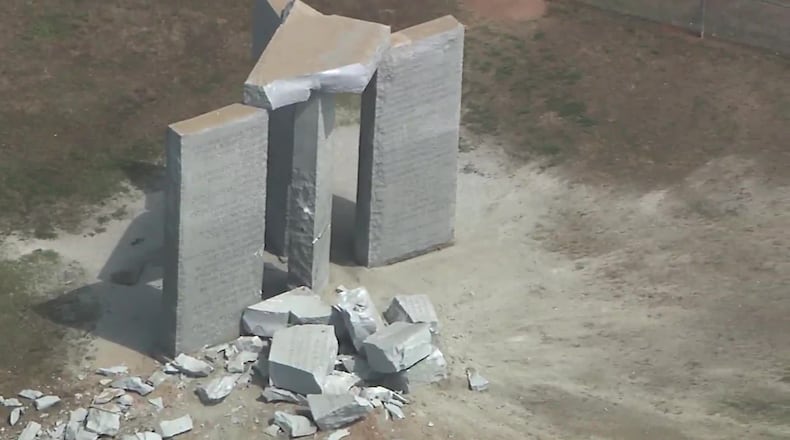The Georgia Guidestones had been the subject of wild and arcane conspiracy theories long before they were blown up last week, but interest in the mysterious monument picked up in the months leading up to the attack.
County officials fielded regular complaints, queries and demands to remove the monument, according to emails, meeting minutes and other documents obtained by the Atlanta Journal-Constitution through open records requests.
Some of the communications accused the county, which owned the land upon which the monuments sat, of supporting terrorism, and a fringe candidate in the Republican gubernatorial primary released an ad this spring promising to destroy them if elected.
Elbert County Administrator Phil Pitts told the AJC criticism and calls for the removal of the Guidestones had “accelerated significantly” in recent months. In hindsight, he said, the county should have seen the attack coming.
“The odds are much higher than ever before that something would happen, but we didn’t take that warning,” he said.
The Guidestones were a series of 19-foot-tall granite monoliths installed in 1980 at the request of an anonymous individual or group seeking to transmit instructions for a future “age of reason.” The instructions, carved in eight languages, have long been the subject of conspiracy theories because they call on some future society to “maintain” a worldwide population of just 500 million, settle international disputes in a world court, and improve “fitness and diversity” in reproduction.
The carvings prompted fears in some of shadowy figures promoting a world government. Last August, one man accused the county of promoting “domestic terrorists.”
“I am concerned because those guidestones promote the destruction and death of almost 6.5 billion people,” he wrote. “Why haven’t the owners and the people who erected those stones, and whose land on which they stand been put in jail and imprisoned for promoting terrorism?”
On March 30, a woman wrote to the county government asking if the Guidestones could be “dismantled.”
“I’m sure many feel the same as I do, when I say they have no place in the United States of America. I don’t believe that any God fearing American feels this way or has ever,” she wrote. “Do we need to do a petition, or can they just be quietly taken down.”
A June 15 unsigned email to a county official accusing the monument of “supporting genocide of the world population” led Commission Chairman Lee Vaughn to direct that a log be kept of such messages “so we can track this.”
Just two days earlier, the county board had sat for nearly a half hour as a pastor from neighboring Franklin County urged commissioners to remove the monument for the same reason.
“This monument that is in Elbert County advocates the killing of 6.5 billion people,” Pastor Clint Harper said.
The commissioners pushed back on the claim, saying the Guidestones were just a tourist attraction with “a bunch of nonsense” carved on them.
On July 6, an early morning blast ripped apart one of the four monoliths. A crew took down the rest of the monument later that day for the protection of criminal investigators.
The Georgia Bureau of Investigation is investigating the bombing and has released surveillance video showing a black-clad figure rushing to and from the monument and a silver sedan speeding away. No suspects have been named and the GBI has been tight-lipped about its progress.
While county officials didn’t add extra security to the Guidestones site as complaints and questions mounted, they weren’t ignoring the increased interest in them.
Some of the emails received by county officials referred to a time capsule believed to be buried underneath the monument. Officials looked into it as recently as this spring after a woman from Wisconsin began emailing and calling about it.
In a May 19 email to Elberton Granite Association Executive Vice President Chris Kubas, Pitts said he drove out to the site to investigate and even spoke to one of the last surviving people involved in erecting the monument, a man named Hudson Cone.
“Hudson’s comments were that there was not any Time Capsules buried there,” Pitts wrote.
Emails from the woman show she was unconvinced.
“Well this Mr. Cone guy is lying,” she said. “Just tell them a girl is interested in the time capsule that’s buried beneath the Georgia Guidestones and wants to know if she can dig it up. Either way I’m going to so I guess it doesn’t matter what they say.”
In an interview with the AJC, Kubas said a search was made for the capsule when the Guidestones were removed. He said a crew using heavy machinery dug six feet down until they hit “hardpack” red clay but found nothing.
Since the bombing, the county has received numerous messages offering support to rebuild the monument, and there is local support for such a project, especially among those who regret the loss of tourist dollars.
“We are fully supportive of the Guidestones being reconstructed, whether by the county or another local entity or collaboration,” Rebecca Holliday, executive director of the Elbert County Chamber of Commerce, wrote in an email to local government and business officials a day after the explosion.
Commissioners met in executive session Monday to discuss the future of the county-owned plot where the Guidestones sat. Pitts said the decision was made to wait and make a decision when the issue cools down.
“I happen to agree with the position of the board to take a breather on this,” he said.
It may be a while before the issue cools, however. On Tuesday morning Appling County resident Kandiss Taylor, the unsuccessful candidate who promised to take down the monument, posted a video on Twitter saying she had been the victim of a “swatting” incident.
Swatting is where someone makes a hoax call to 911 that leads police to believe that there is a dangerous situation at the victim’s house. GBI spokeswoman Nelly Miles confirmed the agency is looking into the call through its Georgia Cyber Crime Center.
THE MONUMENT
The Georgia Guidestones monument was built in 1980 from local granite, commissioned by an unknown person or group under the name R.C. Christian.
The four 19-foot-high panels carried a 10-part message in eight different languages with guidance for living in an “age of reason.”
It also served as a sundial and astronomical calendar.
About the Author
Keep Reading
The Latest
Featured


